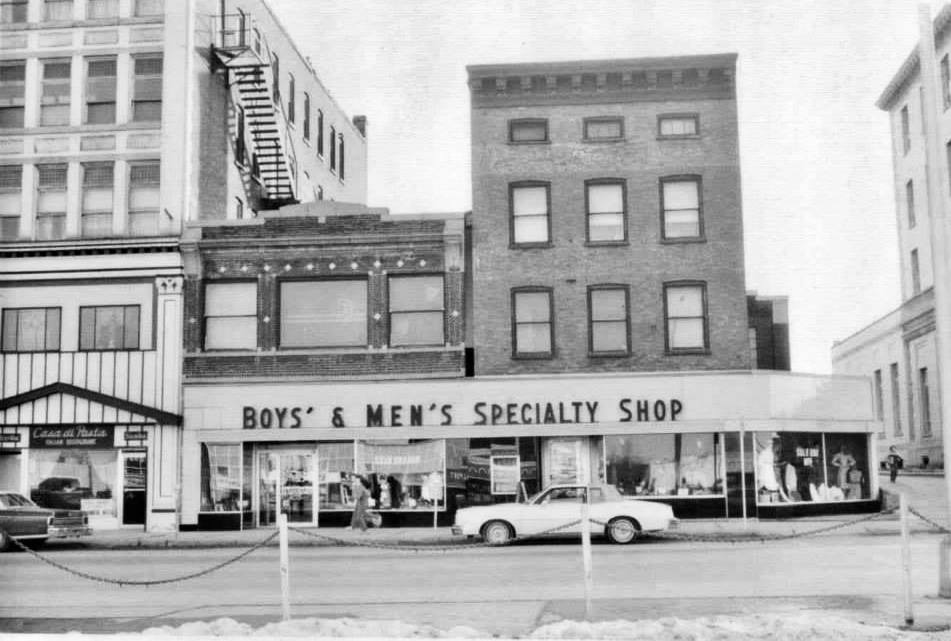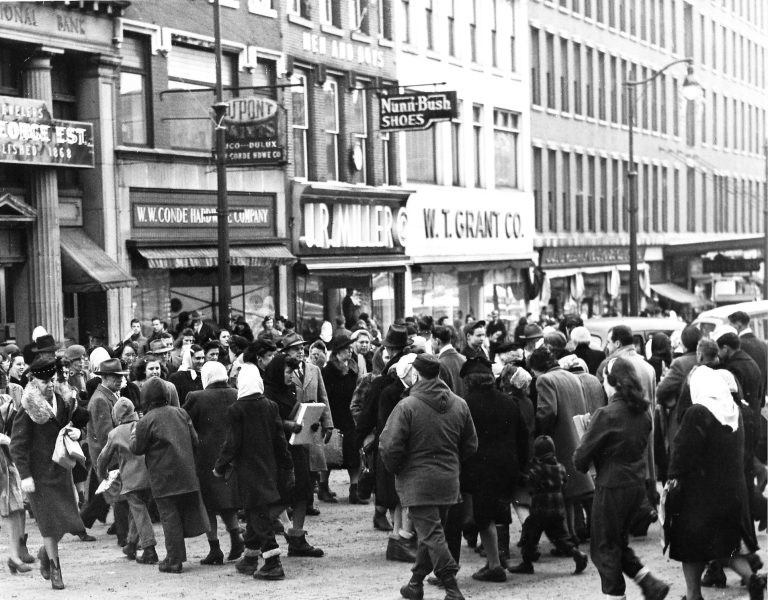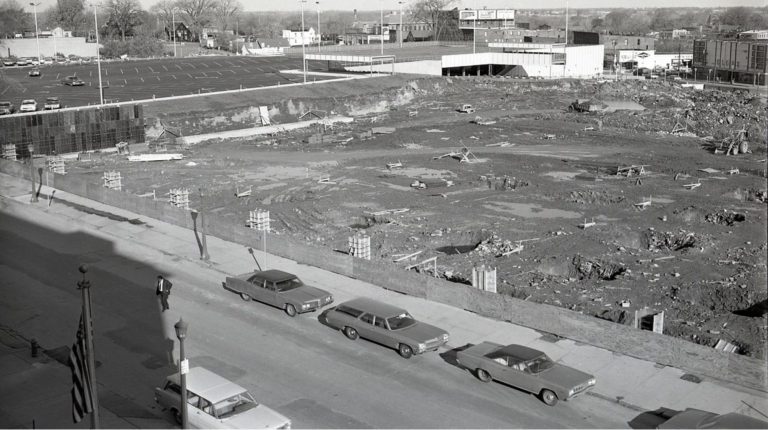The 1940s and 50s Were Record-Breaking For Christmas Shopping In Watertown, NY
Up until the opening of Salmon Run Mall in 1986, the majority of Christmas shopping that occurred over the prior decades took place in Public Square. Coming off the heels of the Great Depression and then the subsequent involvement in World War II, the 1940s would see unprecedented shopping in the heart of downtown Watertown, where thousands would flock, breaking records nearly every year that defied trends across the country elsewhere.

With its many stores including the likes of J.R. Miller Co., Sears, JCPenney, The Globe, Bee-Hive, George’s Jewelers, Rothschild’s, Richards Clothes, Woolworth, Max Alpert Inc., along with eateries like the Crystal Restaurant, the Lincoln Restaurant, the Tavern, Sugar Bowl or just stepping into Paddock Arcade, stomping your feet free of snow and breathing in the rich aroma of Karmelkorn to warm your spirits, downtown was the place to shop until you dropped.
The Christmas shopping season of 1940 was the most profitable in 15 years, the Watertown Daily Times remarking as the holiday neared, “in many instances, stocks of local establishments were depleted, and store-owners are making quick inventory to re-stock for the expected better than normal business the remainder of the week.”
The 1940 Christmas shopping season was also one of the warmest seasons in recent memory. Christmas day would see the mercury rise to 51 degrees, the third warmest in more than 40 years. The Christmas eight years prior in 1932 held the record at the time with 60 degrees, the warmer than usual holiday seasons in both instances sending shoppers out in full force, unabated by snow.
1941 saw the United States enter into World War II, the Christmas shopping activity briefly slumping as a result earlier in the week but rebounding full-force by the weekend as reported by the Times–
When the United States declared war on Japan Monday and then followed with the declarations against Germany on Wednesday, business bogged down but the condition proved to be only short-lived for volumes began to spurt to new levels later in the week and then reached a peak on Saturday.

As the War continued into 1943, shortages were common, particularly with toys for boys, although military-themed toys had surged in popularity. Shortages included typical toys such as electric trains, tricycles, sleds, and erector sets. The Times noted–
This shortage of customary toys is reflected in an unusually large sale of children’s books, of which there still seems to be a fairly abundant stock. The paper shortage does not seem to have hit publishers yet.
1945 would see an unusual public emergency declared during the Christmas shopping season due to weather-related circumstances. The Watertown Daily Times would note Mayor Charles A. Winslow‘s declaration–
“We have given orders that any violator of the emergency proclamation will be prosecuted,” Mayor Winslow said today. “The regulations are severe but this must be so if we are to succeed in getting near-normal traffic flow throughout streets.”
The proclamation was issued, according to city officials, after street plowing capabilities were reached and unmanageable traffic jams plagued commercial and private vehicles, especially along bus routes and arterial traffic boulevards.”

1946 would see records break as stores were “thronged” with shoppers. That Friday after Thanksgiving, the Watertown Daily Times reported–
Record-Breaking Holiday Trade Reported In Watertown By Merchants
An army of shoppers thronged the Watertown business section Friday in the biggest single-day Christmas buying spree yet. Business also continues heavy today.
Stores were jammed for most of the day Friday and pedestrian traffic on Public Square adjoining business streets took on a metropolitan atmosphere. Retailers said the day’s volume was undoubtedly higher than the same day last year but comparative reports have not been made.
Nearly 10 days later, retail stores in the city were forecasting 15 to 20 percent gains from the previous year as the record sales continued.
1947 would see an all-time record for the dollar turnover. Although the volume of goods in most cases was down, the prices were higher. A Saturday in mid-December was reported by many local merchants to be the greatest shopping day in Watertown’s history. Stores were reportedly thronged from open until close as the scene was described by the Times as “the streets and sidewalks of the business section were hard pressed to contain the flow of automobile and pedestrian traffic.”

In 1948, sales were running close to record-breaking volumes for the same period set the previous year. The Times reported–
While sales for most of the stores are about equal to those of 1947 for the shopping period up to date, there are at least two establishments which, this season, have shown drops down to two percent.
Watertown, thus, apparently is an exception to the national trend of holiday business which has shown big declines for five consecutive weeks over the 1947 comparative period (thru mid-December)

The trend would continue into the 1950s, as masses of people made Watertown look like a metropolis. Another trend saw shoppers seeking to get an early start in October while stocks were available. Nevertheless, the Friday after Thanksgiving had taken hold as one of the busiest, with schools out for the holiday.
In 1951, traffic was reportedly so unexpectedly high at one local merchant, that there weren’t enough clerks to handle the volume despite the additional staffing measures taken. The beginning of December would see the biggest two-day totals to date as the weather was mild and factored favorably with the Christmas shopping.
1952 would see more of the same with arguably one of the most beloved photos representing the glory days of downtown, Watertown at its shopping peak shown below:

1954 would see put Watertown on the map, well, on the Woolworth holiday catalog to be precise, as the store founded by local F. W. Woolworth would commission artist Paul Rabut to paint the iconic Christmas shopping scene on the American Corner of Public Square with Santa Claus holding a small child with the Woolworth store in the Woolworth building behind them as snow falls. It’s a scene that surely warms one spirit and brings joy to the season, not too unlike having a Tom & Jerry from the Crystal Restaurant.

In 1955, Christmas Shopping in Watertown got off to an early start with a sharp increase compared to the previous season, with record-high sales predicted. The Watertown Daily Times reported on the post-Thanksgiving day shopping–
Stores were jammed with customer traffic throughout Friday and store managers said that sales for the day gained from five to 18 per cent over the corresponding day in 1954. Traffic was also heavy Friday night as the night store opening policy began.
The business section of Watertown took on a metropolitan atmosphere Friday as shoppers moved from store to store intent on buying their Christmas gifts early this season. Store officials said that a large percentage of the buyers were from out-of-town.

Two years later, after the Christmas shopping season got off to a sluggish start, it picked up sharply by mid-December with hopes that steady traffic would bring it near the previous year’s record-breaking level. The 1958 season proved to be on par with the ’57 season.
1961 Saw “Yule Spirit Defeats City Blue Laws” when scores of shoppers right before Christmas made gift purchases on a Sunday despite one shopper who turned around and reported the violation to the police (imagine that!). The owner of the identified store was notified of the violation, but in true Christmas spirit, no action was taken.

Warm weather the first weekend of the 1962 shopping season in December brought booming business to downtown retailers. Local stores were reportedly packed with local and Canadian shoppers who came out in droves for the unseasonably warm weather.
1963 saw a very good holiday season, The Times reporting on December 23–
Many business officials are enthusiastic over the sales recorded Saturday. The manager of one large department store lauded the city of Watertown for keeping the parking lots and streets in good condition, and to radio stations for describing the good conditions of the roads in the area.
The official said much of their business Saturday was from out-of-town customers. He said they had no complaints regarding the volume of business.
The manager of one downtown department store reported Saturday’s trade was up as much as 20 percent over a year ago.
The 1963 Christmas shopping season also saw a tremendous shortage of coins around the country, prompting many businesses to request customers pay with the exact change.

The 1940s, 50s and early 60s presented the peak of downtown Christmas shopping with urban renewal taking place in the 1960s. A good portion of the Court Street shopping district was lost, and although replaced with City Center Mall, it would never be quite the same again. The 1970s represented an era in between the loss of a number of businesses and store relocations that took place in the 1960s due to urban renewal and what would later become the mass exodus of stores from the downtown scene in the mid-1980s to Salmon Run Mall.






















